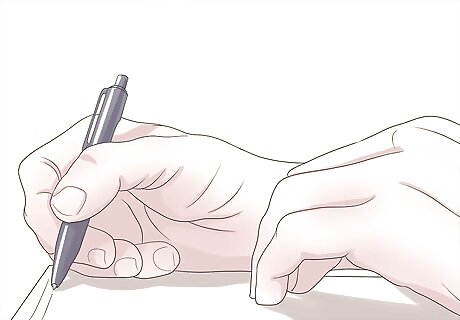
views
Getting Ready

Consult your organization's rules on committees. Many organizations, including universities and nonprofits, have rules in place for how committees should be run. You should review these rules thoroughly before starting out. If you can't find them on your organization's website, ask someone in authority where the rules can be found.

Focus the purpose of the committee. If the committee is brand new (and even if it's not), you need to ensure that it is focused properly. The best way to focus your committee is to have a specific goal in mind for it. For instance, maybe you are forming a committee to assess how a product is doing. That is the primary goal of the committee. Think about whether the committee will primarily be advising or will actually be implementing solutions. You also need to be clear about how much authority the committee will have. Of course, the main organization should make this decision, but you should present your opinion before the committee meets. Work in tandem with the organization or the boss who wants the committee formed to make these decisions.

Make sure you are knowledgeable. It's likely you were chosen as committee chair because you are already knowledgeable in the area. However, make sure to continue doing your homework. To be a leader, you need to be able to see the whole picture, which means that you need to study each piece your committee is focusing on. That way, when solutions are brought to the table, you can decide if they will be effective or not.

Engage in discussions with the previous chair. The old chair should provide you with information on the committee and what your role should play as the committee chair. They can also provide you with information about individual members of the committee. The old chair should also provide you with documents about the committee, such as what the main policies are, what meetings are scheduled, and what the committee has been doing in the past year.
Finding Members

Create criteria. Look at your goals and tasks from above. Write out a list of skills that are needed to help fulfill those goals. For instance, if your primary goal is to fundraise, you'll need people who are good at organizing, who can connect with other people, and who are creative.

Establish good relations with old members. If the committee is already established, it will already have members. That doesn't mean that every person on the committee should stay on it. Consider how the committee will move forward and which members best fit that goal. With that in mind, you may need to ask members to step down if you feel they are not contributing to the main goal. However, you must do so carefully, especially if you are running a volunteer committee. You need to maintain goodwill with your volunteers.

Use your criteria to select new members. If it's your responsibility to recruit or appoint members, you need to make sure you are appointing people for the right reasons. Once you've established the main goals and tasks of the committee above, that can help you establish who would be good members. That is, consider the skills of the employee or volunteer before asking them to join the committee. The person's skills should contribute in some way to your goals. If you don't know who would have particular skills in your organization, ask around. You may find recommendations land you many new members.
Running Meetings

Take the head seat. If there is a head seat in the room you are using, it's appropriate for you to take it. You are the leader, and you are visually establishing that by taking the head seat. On the other hand, if you want to establish a more informal setting, you might sit in the middle of the group. It will make you more approachable, though it may cut down a bit on your authority.

Set up the rules upfront. If the committee is new, explain how it will be run. That is, if you have specific rules about how an idea will be brought up, now is the time to lay those rules out. You should also have a handout of the rules so that your members can refer back to them later. For very formal committees, some people turn to Robert's Rules of Orders Newly Revised. It provides rules for how committees are run. You can also establish any rules for any misconduct, include people coming late to the meetings, not being prepared, or taking over a meeting completely.

Ensure the purpose is clear. You've already established the purpose of the committee for yourself. However, your members need to be clear on what the purpose is as well. Go over the purpose in the first meeting. In addition, you should be clear about what each member should contribute in terms of time and ideas. You should also have the purpose in writing to help guide your members throughout the time they are on the committee.

Make sure the rules are followed. Once rules and consequences are in place, you have to be the one who makes sure they are followed. That means following through with any consequences in a fair and just manner. It always pays to be diplomatic, even when someone is breaking the rules. As an example, if you have all agreed that no one can talk for more than 10 minutes with the exception of special presentations, when someone is going over, you need to step in. However, instead of saying, "John, you need to be quiet now. You're way over time." you could say, "Thanks, John, for that valuable information. I know you have more to say, but maybe you can put it in a short email to all our committee members so we can be sure to cover all the items on our agenda today."

Always have an appropriate written agenda. Agendas guide meetings because they help the group focus on a few main ideas. You must make sure that the agenda is appropriate. That is, you must make sure that you have enough time to give each item on the agenda the attention it needs. If you have too much on it, you'll be forced to skip over some items. Hand the agenda out a day or two before the meeting so members can be prepared. Make sure each person knows what they are responsible for on the agenda beforehand.

Have someone take minutes. If the committee doesn't have an established secretary, make sure someone takes minutes at every meeting. That way, you can have something to refer back to when you want to know what happened at each meeting.
Continuing the Committee

Communicate often. Once you've had your first meeting, make sure to maintain regular communication with your members. Offer regular updates on meeting times, as well as synopses of the meetings. You'll also need to provide updates as new information becomes available.

Put the committee above your personal agenda. It's important that your personal agenda (such as advancing in the company) doesn't come before the committee. That means that you place more importance on the committee succeeding in its goals than on you succeeding in your own goals.

Encourage creativity. One of the key points of encouraging creativity is that you build up members rather than tear them down. If you are constantly berating members in front of the group for their ideas, they will soon stop volunteering ideas. Therefore, it's important to make the committee a place where you are accepting of new thoughts and ideas, even if they seem strange at first.

Gain new members. As old members go off the committee, you'll need to recruit more members. As you do, make sure you provide them with an appropriate orientation that covers the rules and focus of the group, just as you did when you started with the committee. Help the new person to figure out how they can engage with the committee.

Don't forget to be thankful. Many times, members do not need to be on a committee, and they are volunteering to do so. Keep that in mind as you run your committee, and offer your thanks in writing and in person for what they do to make your committee a success.


















Comments
0 comment